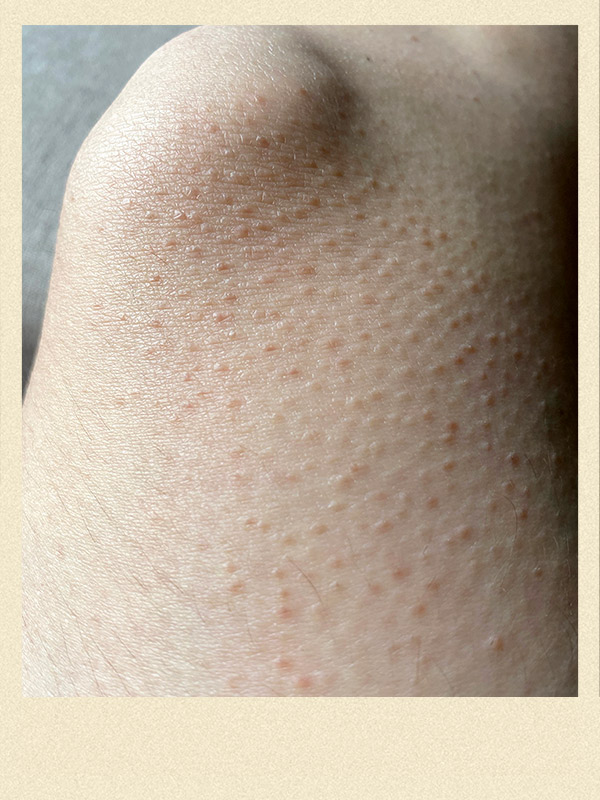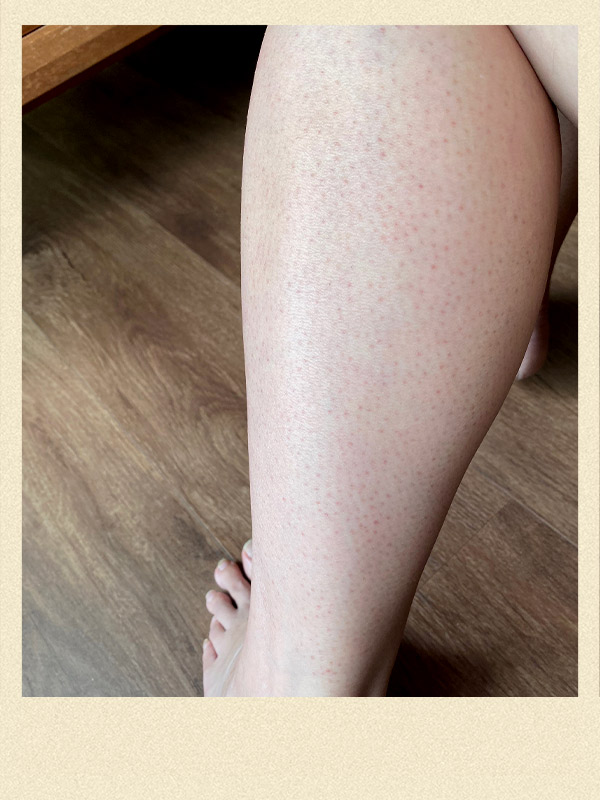I have chicken skin on my legs and I'm OK with it

I've been obsessed with "chicken skin" since I was a teenager.
To all you lucky souls blessed with smooth skin, the "chicken skin" I'm talking about is not that sinful new item on the KFC menu, but the bumpy skin on my body.
And when I say obsessed, I don't mean I love it to bits-I was determined to get rid of it.
WHAT IS "CHICKEN SKIN" OR KERATOSIS PILARIS?
The medical term for chicken skin is keratosis pilaris (KP). It is a condition that causes numerous tiny red, white or flesh-coloured bumps to appear on the skin.
According to Dr Tan Hiok Hee, at Thomson Specialist Skin Centre, the condition is caused by "a disorder of keratinisation of the hair follicles".
The build-up of keratin in the follicles then causes raised bumps on the skin which looks like "chiken skin".

"It is not clear why this occurs, and there can be a genetic predisposition," says Dr Tan.
He goes on to explain that it typically starts in adolescence and tends to get better, but there are variants which persist into adulthood.
Some variants are associated with nutritional deficiency, although this is not commonly seen.
KP is a fairly common condition and usually appears on the upper arms, legs, buttocks and sometimes, face.
Some bumps may even have ingrown hair in them, and I confess that to this day, I have the bad habit of running my hands over the bumps to see which ones I can pick at.
IS KERATOSIS PILARIS HARMFUL?
Fortunately, it is a benign condition and considered to be a variant of normal skin.
The good news is that the bumps are totally harmless and don't really itch, so most of the time you won't even notice that they are there.
For me, I was aware of the bumps on my legs, knees, and the back of my arms ever since I was a kid.
I don't remember when I developed KP, but I started noticing the bumps when I was eight or nine.
I would look down at my legs from time to time and wonder why there were so many red dots scattered all over my legs.
I would also rub my arms and wonder why they always felt so rough. However, that didn't stop me from wearing shorts and sleeveless tops, especially since I did a lot of sports in school.
I figured that since none of my friends commented on my skin, it wasn't such a big deal.
However, as I grew older, it became harder for me to ignore these bumps.
Since the hair on my legs began growing fast and thick, I started waxing and epilating at 14.
The constant pulling and tugging of hair made my pores bigger and I started getting ingrown hair and inflamed skin.
One day, I realised that I could clearly see every pore on my legs and that they looked even more prominent than before.

I decided that I could not risk irritating my pores any further and decided to go for laser hair removal treatments. It was one of the best investments I have made.
However, while it got rid of the hair and resolved my ingrown hair problem, I was still left with the rough bumps that can look especially red and angry when I apply pressure on my legs-like when I cross my legs.
And people were starting to notice. Once, while we were chatting, my friend glanced at my knee and brushed her hand against the bumps and asked, "Eh, how come so rough one ah?"

I knew that she wasn't trying to make me feel self-conscious or bad.
Her question stemmed from curiosity since she didn't know what KP was, but it made me determined to make my skin smooth and normal-looking just like everyone else.
CAN KERATOSIS PILARIS BE TREATED?
When I asked Dr Tan for the purpose of this article, he said good moisturisers, and sometimes mild exfoliants can help treat mild cases of KP, while for more severe cases, topical tretinoin (a vitamin A derivative) can be used.
While I haven't tried tropical tretinoin, I've experimented with different ways to get rid of the bumps over the years.
I've tried using products such as sea salt scrubs, and exfoliating brushes and towels to try and smoothen the bumps.
I even attempted to make my own body scrub with oatmeal because I read that it has anti-inflammatory properties and was good for the skin.
Sadly, nothing really worked for me and all I ended up with was red and sensitive skin from all the abrasion.
I've also tried asking facialists and consulted skin doctors about my KP, and the answers were to either just scrub more, or not to worry and that it will eventually lessen over time.
LEARNING TO ACCEPT KERATOSIS PILARIS
Over time, I told myself to just give up fighting KP and just accept it.
I mean, there's really nothing much you can do when there's supposedly no cure and the condition doesn't affect your health in any way, right?
When I asked my then-boyfriend (now husband) what he thought about my KP, he looked puzzled and said, "Have meh?"
I showed him the red bumps on my arms and legs and was a bit apprehensive about what he might say.

But he just looked at them, caressed the bumpy skin on the back of my arms and said that the bumps don't bother him, and he doesn't notice them at all.
This made me realise that a lot of my negative perception about KP was all just in my head and that if someone can love me with my KP, I can love myself with it too. And it took me 20 years to realise this.
I have since stopped obsessing over the appearance of my KP.
Although, by a stroke of luck, I found out that salicylic acid does seem to help make my skin smoother and make it less bumpy.
However, I'm OK with the fact that the bumps will never go away permanently and that they will always be a part of me.
KP or "chicken skin" might be annoying and an eyesore to some people, but in the grand scheme of things, I am thankful that it doesn't pose a danger to my health and that it doesn't cause me any discomfort or pain.
That said, I will still continue using salicylic acid on my KP because after so many years, it is a joy to touch the back of my arms and finally find them feeling softer and smoother.
This article was first published in CLEO Singapore.